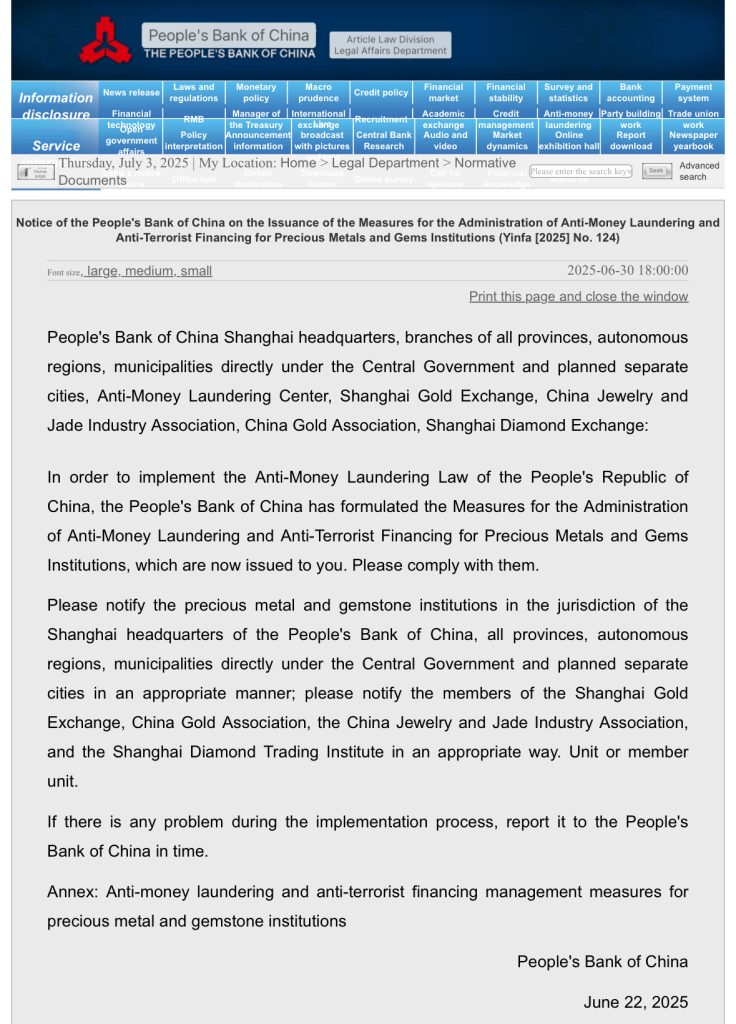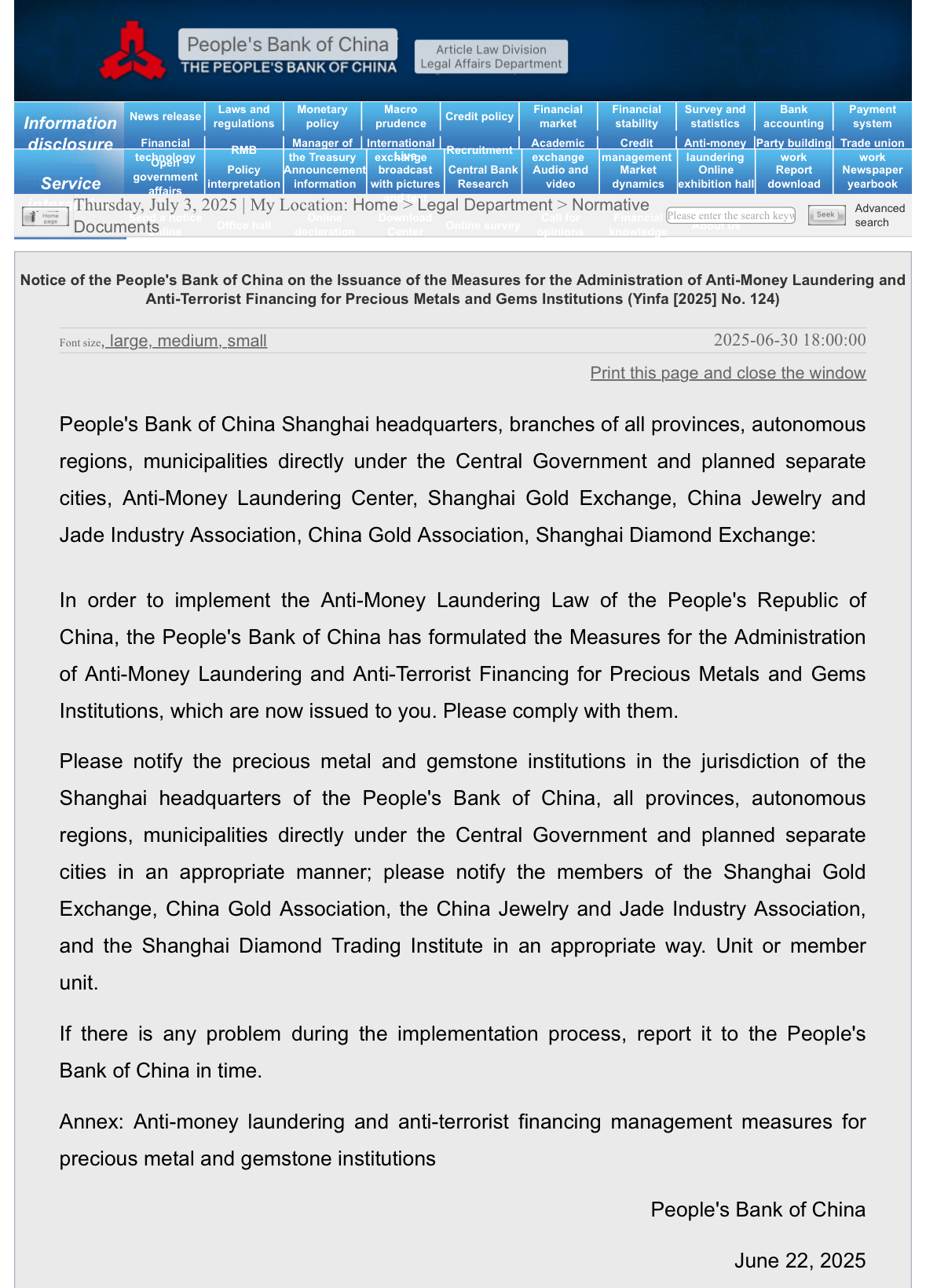
As of 12:54 PM HKT on Thursday, July 3, 2025, the People’s Bank of China (PBOC) has introduced significant regulatory changes targeting the precious metals and gemstone industry, set to take effect on August 1, 2025. These new rules mandate that institutions engaged in the trade of precious metals and gemstones must report any single cash transaction or cumulative daily transactions exceeding 100,000 RMB (approximately $13,977 USD) to the China Anti-Money Laundering Monitoring and Analysis Center within five working days of the transaction. This article examines the rationale behind these regulations, their operational implications, and the potential challenges for industry participants, while offering a critical perspective on their broader economic and social impact.
Rationale and Objectives
The PBOC’s new regulations are designed to strengthen anti-money laundering (AML) and counter-terrorism financing (CTF) measures within a sector historically vulnerable to illicit financial activities. Precious metals, including gold, silver, platinum, and gemstones such as diamonds and jade, are often used as vehicles for laundering money due to their portability, high value, and relative ease of conversion. The threshold of 100,000 RMB reflects an intent to target high-value transactions that may signal suspicious activity, doubling the previous reporting limit of 50,000 RMB. This adjustment aligns with China’s broader strategy to enhance financial transparency and comply with international standards set by the Financial Action Task Force (FATF), addressing criticisms of past gaps in oversight, as noted in earlier assessments.
The regulations also aim to standardize practices across the industry, encompassing raw materials, jewelry, and processed products. By imposing strict reporting obligations, the PBOC seeks to deter money laundering linked to crimes such as drug trafficking, corruption, and terrorism financing, which have been identified as significant risks in China’s financial system. However, the timing of this policy—announced amidst global economic uncertainty and a strengthening U.S. dollar—raises questions about whether it also serves to tighten capital controls amid potential capital flight pressures.
Operational Implications for Industry Participants
For dealers and institutions, compliance with these new rules necessitates significant operational adjustments. Institutions must implement robust “Know Your Customer” (KYC) procedures to verify the identity of clients involved in transactions exceeding the threshold. This includes collecting detailed documentation and conducting due diligence based on the transaction’s nature and associated risks. Additionally, the requirement to submit large-value transaction reports within five working days demands enhanced record-keeping systems and streamlined reporting processes to the China Anti-Money Laundering Monitoring and Analysis Center.
The scope of the regulations is comprehensive, covering not only trading but also manufacturing, refining, and value-adding activities related to precious metals and gemstones. This broad application may increase operational costs, particularly for smaller businesses that lack the infrastructure to manage compliance efficiently. Larger firms with established AML frameworks may adapt more readily, potentially gaining a competitive edge. Nevertheless, the increased regulatory burden could deter cash-based transactions, pushing the industry toward digital payment systems, which may align with the PBOC’s long-term goal of promoting the e-CNY digital currency.
Compliance Challenges and Industry Sentiment
The implementation of these regulations presents several challenges. First, the five-day reporting window may strain institutions with high transaction volumes, especially during peak trading periods such as the Lunar New Year or festive seasons when jewelry sales surge. Second, the lack of detailed guidance on cumulative daily transactions—whether these apply to a single client or across multiple clients—creates ambiguity, potentially leading to inconsistent compliance practices. Industry stakeholders have expressed concerns about the feasibility of verifying the legitimacy of cash transactions in a sector where anonymity has traditionally been a selling point, particularly for high-net-worth individuals.
Posts found on X indicate a mix of reactions, with some users questioning whether jewelry stores will now need to archive all customer cash purchases, suggesting a potential overreach that could alienate consumers. Others view the rules as a necessary step to curb illicit flows, though no official statements from PBOC executives or industry leaders have clarified these concerns as of now. This inconclusive sentiment underscores the need for the PBOC to provide transparent implementation guidelines to mitigate confusion and resistance.
Broader Economic and Social Impact
Critically examining the establishment narrative, these regulations may have unintended consequences. While aimed at enhancing financial security, they could disrupt legitimate trade by imposing excessive scrutiny on small-scale dealers and artisans, who form a significant part of the precious metals and gemstone ecosystem. The shift toward digital transactions might exclude rural or cash-dependent populations, exacerbating financial inclusion disparities. Furthermore, the focus on cash transactions could drive illicit activities underground, into unregulated channels such as peer-to-peer transfers or cryptocurrencies, which are already under scrutiny in China.
Economically, the policy may influence gold and gemstone prices domestically, as increased compliance costs could reduce market liquidity. Internationally, it may signal China’s intent to assert greater control over its financial markets, potentially affecting global trade in precious metals. Investors and analysts should monitor how these rules interact with existing capital controls and the e-CNY rollout, as they could reshape China’s role in the global luxury goods market.
Conclusion and Recommendations
The PBOC’s new regulations, effective August 1, 2025, represent a pivotal shift in regulating the precious metals and gemstone sector, aiming to fortify AML and CTF frameworks. While the intent to combat financial crime is laudable, the success of these measures hinges on clear implementation guidance, adequate support for smaller businesses, and a balanced approach to avoid stifling legitimate trade. Industry participants are advised to begin upgrading their compliance systems immediately, focusing on KYC processes and reporting infrastructure. For investors, the policy’s impact on market dynamics warrants close observation, particularly as it unfolds against the backdrop of global economic volatility. Further dialogue between regulators and industry stakeholders will be essential to ensure these rules achieve their intended objectives without unintended economic distortions.
